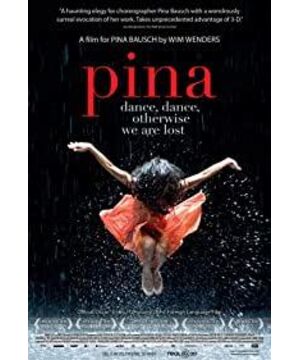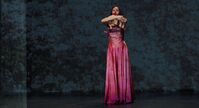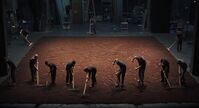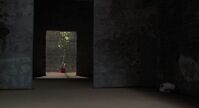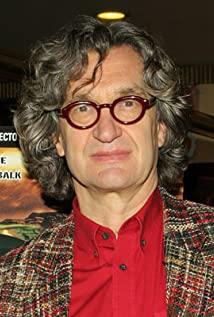I'm actually a person who doesn't understand dance at all. In modern dance, the only person I can name is Isadora Duncan, the mother of modern dance. When I was in junior high school, I read her autobiography, the Chinese translation of "Song of the Dancer". The writing was smooth and bold, and I fell in love with it all at once. She wore an ancient Greek-style dance dress with a long hem hanging on the ground and dancing a thousand times. I was fascinated by her writing about her dancing in front of the theater manager, and he was so amazed that he couldn't recover, and about Rodin stroking her body in a daze and couldn't hold back. . So for a long time, the unbridled gesture that blooms between heaven and earth in Duncan's black and white dance photos constitutes my highest understanding of dance.
This time I watched the movie "Pina", but the dance of German dancer Pina brought a different feeling. She unfortunately passed away when the film was filmed, so this movie named after a person just lacks a protagonist, and can only piece together Pina's sense of presence that cannot be ignored through the only light film of dancing. When Duncan rebelled against classical ballet in his early years, he said that their elegance is hypocritical elegance, and behind the perfect proportions and strict movement requirements is a dead soul. Pina, however, seems to have rebelled even with elegance: the expressions of the dancers are rarely calm and joyful, and are always shrouded in fear, doubt, insecurity, and a lack of security. In the opening dance "Rite of Spring", the dirty costumes and trembling and messy movements are even more irrelevant to elegance. When I listened to Stravinsky's "Rite of Spring" at the beginning of the year, I couldn't get used to the hustle and bustle, and then I gradually realized its enormous appeal; I didn't expect to see Pina's "Rite of Spring" interpreting with dance, and it was even more incomprehensible. When I looked closely, I found that there were so many people in the group dance that no two danced in the same way, and the terrified dance steps and terrified facial close-ups of the girls as they waited for who was selected as the sacrifice instantly hit the eyes, and their hearts were suspended in the air.
is human nature. Not an exhibition on the table, but a bloody dissection, naked to the most vulnerable nerves. After each dance there is an interview with the dancers, and everyone has a story in their eyes. If it is said that what Duncan liberates is beautiful human nature, like sunshine, grass, and sea, the human power transmitted by Pina is more like releasing everything in Pandora's box, except for hope. Duncan dances solo to express buoyant statement enthusiasm, while Pina interprets cryptic negativity with the human touch of a ensemble dance. The negativity kind of borders on madness. In the section of the cafe, there is a couple hugging, but a strange person walks in again and again to correct their posture, and then restores the original, and then corrects, and then restores. Later, even if no one interferes again, they repeat this series again and again. The action, faster and faster, until hysterical breathlessness—a frantic, mortal struggle of added dogma and primal instincts. Foucault described how we marginalized madness in the age of rationality in Madness and Civilization, but I think the factor of madness is always hidden in a corner of everyone's heart. Pina magnified this restlessness and showed no room for it.
It is certainly not enough to describe human nature blandly. The key is that the full tension in it makes it always in a posture ready to go, which is necessary to capture the soul. Tension is another key word I want to mention. Pina's dance moves are full of tension, and so is the stage setting. The two tensions blend together, but they also restrain each other, so as not to overshadow one side. The two most impressive dances are related to a dumping move. The first scene was set in a bright meadow, and the actress was wearing a soft gauze skirt, but the scene was abruptly destroyed by the concrete stairs that occupied most of the field of vision. The unexpected scene came, the actress was facing the actor, she leaned forward, and fell straight forward. At this moment, all the softness - the human body, the gauze skirt, the grass, are incomparable to the hard and ruthless concrete, the huge impact makes people scream uncontrollably. Fortunately, the sharp tension was relieved at the moment when the actor caught the actress, and then the scene was performed over and over again, with extreme tension and relaxation. Another set is in a deserted concrete building, with only a small patch of sky visible from the window. The actress's pouring action is slightly gentle, but the tension is infinitely elongated in the empty space.
There is also a dance that takes place in a glass structure. The sunlight is extremely strong, and the shadows are only a few lines of the pillars. The projection on the ground looks like a prison. The woman's constant retention and the man's unequivocal rejection are just like the contrast between the exaggerated curve of her body and the vertical light and shadow on the ground, a tension that distorts time and space.
At the end of the film is an image of Pina waving goodbye. It is said that her last words before her death were, "dance, dance, otherwise we are lost".
View more about Pina reviews


